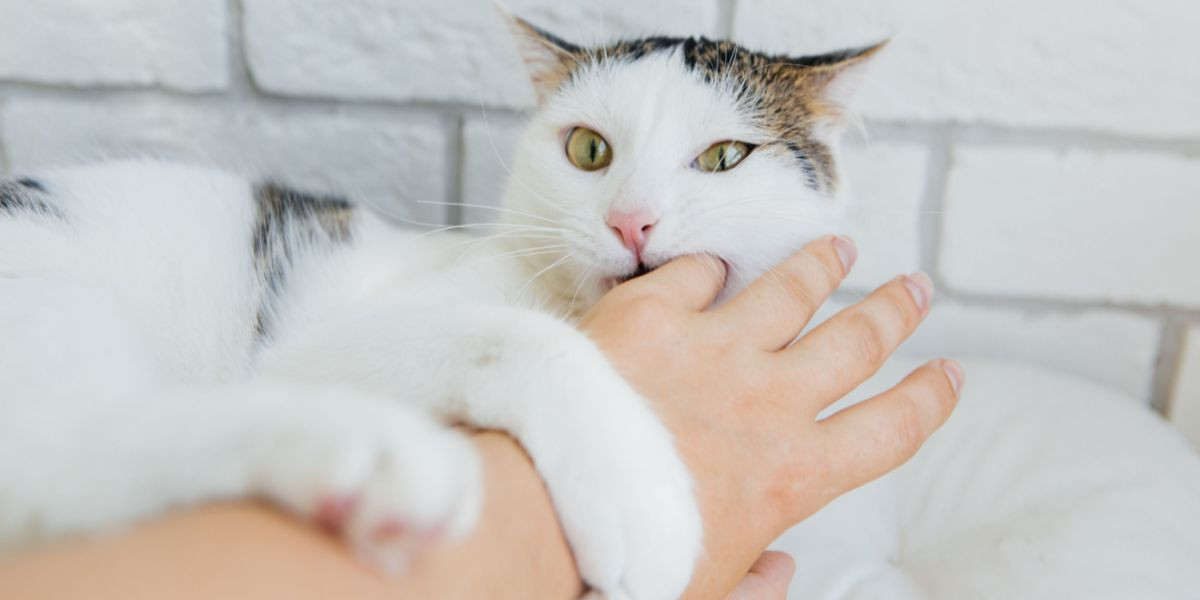 Why do cats bite?
Why do cats bite?
As dedicated cat lovers, we cherish those moments of connection with our feline companions. You’re gently stroking your cat, they’re purring contentedly, and everything seems perfect. Then, out of the blue, you feel a nip or a bite! This common experience, often termed “petting-induced aggression,” can leave cat owners puzzled and even a little hurt.
To truly understand why your beloved cat might suddenly bite during petting, it’s crucial to differentiate these nips from true aggressive bites that stem from fear or defensiveness. By understanding the subtle nuances of cat behavior, we can build stronger bonds with our furry friends and minimize unwanted biting incidents.
Read More: Decoding Cat Behavior: Understanding the Subtle Signs
Petting Bite vs. Aggressive Bite: Knowing the Difference
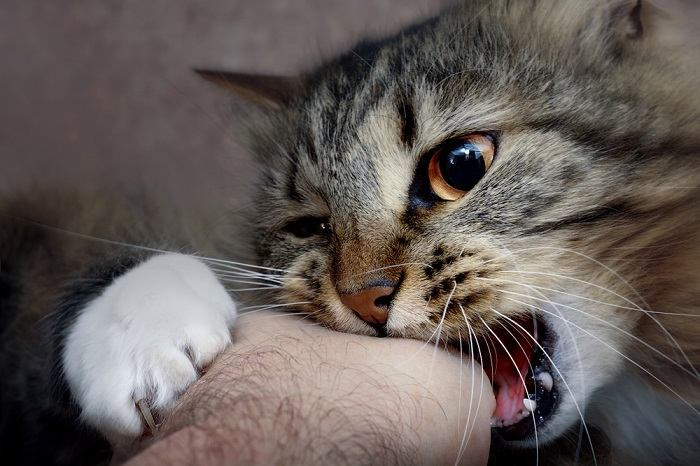 They bite for various reasons.
They bite for various reasons.
It’s important to distinguish between a gentle “petting bite” and a genuinely aggressive bite. A petting bite is usually a soft nip, a gentle pressure of teeth against your skin, often not breaking the skin. Think of it as a feline tap on the shoulder, a way of communicating.
Aggressive bites, on the other hand, are much more intense. They are characterized by skin breakage, bleeding, and significant pain. These bites are often preceded by clear warning signals from your cat, such as hissing, growling, spitting, flattened ears, or swiping. Petting bites, however, often occur with little to no warning, adding to the confusion for cat owners.
Any cat bite that punctures the skin carries a risk of infection. It’s essential to clean any bite wound thoroughly and seek medical attention if necessary.
Read More: Cat Bite First Aid: What to Do If a Cat Bites You
Decoding the Bite: Reasons Behind Petting-Induced Biting
Cats bite for a variety of reasons, and the context surrounding the bite is key to understanding the motivation behind it. When petting is involved, several factors can contribute to this seemingly contradictory behavior.
1. Overstimulation: The Petting Limit
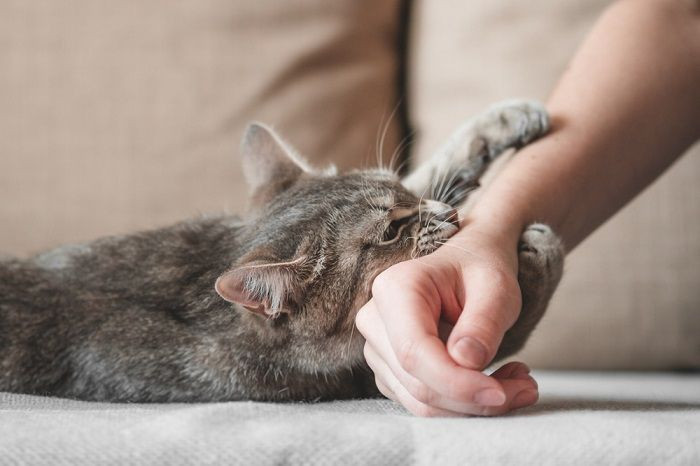 Cat showing signs of frustration.
Cat showing signs of frustration.
Overstimulation is a primary culprit behind petting-induced biting. Cats, unlike dogs, generally have a lower threshold for tactile stimulation. What starts as enjoyable petting can quickly become overwhelming for them. Each cat has a unique “petting limit,” and exceeding this limit can trigger a bite.
Think of it like tickling – initially fun, but quickly irritating if it goes on too long. Cats can become overstimulated through repetitive stroking, especially in sensitive areas. They may initially enjoy the attention, but as the petting continues, it can become irritating, leading to a bite as a way to say “enough!”.
Subtle cues often precede an overstimulation bite. Look out for:
- Tail Flicking: A twitching or rapidly flicking tail can indicate growing agitation.
- Skin Twitching or Rippling: The skin on their back might ripple or twitch.
- Ear Flattening: Ears may start to flatten or swivel back.
- Pupil Dilation: Pupils may widen.
- cessation of Purring: The purring might stop abruptly.
- Body Stiffening: The cat’s body may become tense and rigid.
Respecting these early warning signs is crucial to prevent biting.
2. Static Build-Up: The Unseen Zap
In dry environments, especially during winter months, static electricity can build up on your cat’s fur. Petting can intensify this static, leading to tiny, uncomfortable shocks. These static zaps can be irritating and cause your cat to bite as a reaction to the unpleasant sensation.
Consider using a humidifier to increase moisture in the air, or try using a damp cloth to lightly stroke your cat to minimize static build-up.
3. Misinterpreted Signals: The Belly Rub Trap
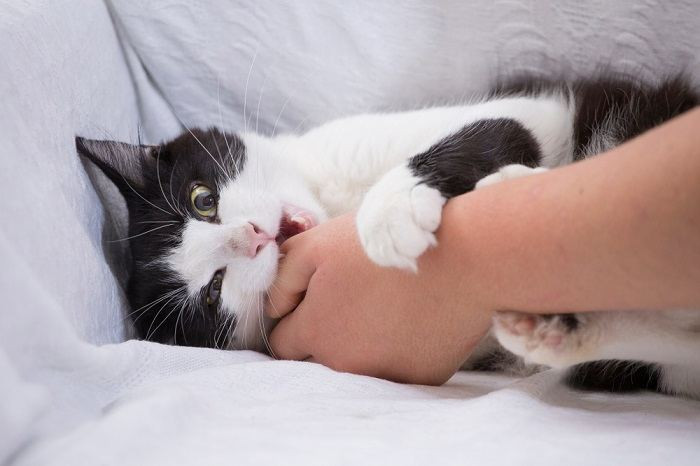 What should you do if your cat bites you?
What should you do if your cat bites you?
A common misconception is that when a cat rolls onto their back, they are always inviting a belly rub. While some cats enjoy belly rubs, for many, the belly is a vulnerable area. Presenting the belly can be a sign of trust, but not necessarily an invitation for petting.
When you reach for their belly, your cat might feel vulnerable or exposed, triggering a defensive bite. It’s essential to learn your cat’s individual preferences. Observe their body language carefully when they expose their belly. Are they relaxed and inviting, or tense and hesitant? Err on the side of caution and avoid belly rubs unless you are absolutely sure your cat enjoys them.
Read More: Belly Up! Decoding Why Cats Show You Their Bellies
4. Redirected Play Aggression: The Hunter Instinct
Cats are natural predators with strong hunting instincts. Sometimes, petting can inadvertently trigger these instincts, leading to playful, but sometimes nippy, behavior. If your cat becomes overly excited during petting, they might redirect their playful aggression towards your hand.
This type of biting is often less intense and more playful, but it can still be surprising. Ensure you provide your cat with ample opportunities for interactive play with toys to satisfy their hunting instincts in a safe and appropriate way.
5. Pain or Discomfort: The Unspoken Issue
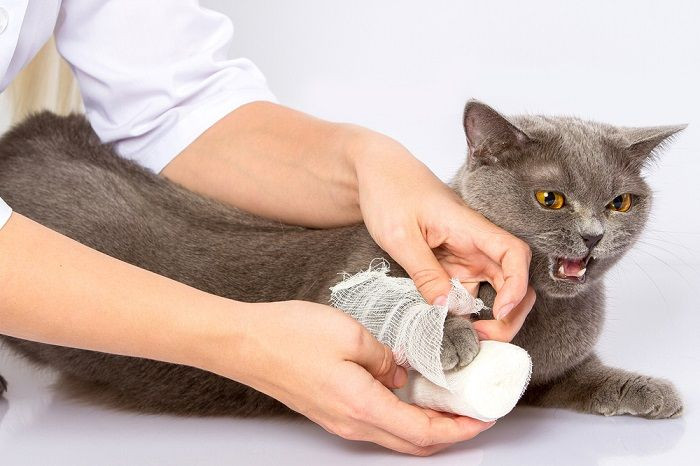 Cat in distress or pain.
Cat in distress or pain.
If your cat suddenly starts biting during petting, especially if this is a new behavior, consider the possibility of underlying pain or discomfort. Cats may bite if they are touched in an area that is painful.
Conditions like arthritis, dental issues, skin sensitivities, or injuries can make petting uncomfortable or even painful. If you suspect your cat might be in pain, a veterinary check-up is crucial to rule out any medical causes for the biting behavior.
Read More: Recognizing Pain in Cats: Signs and Symptoms
6. Learned Behavior: The Attention-Seeking Nip
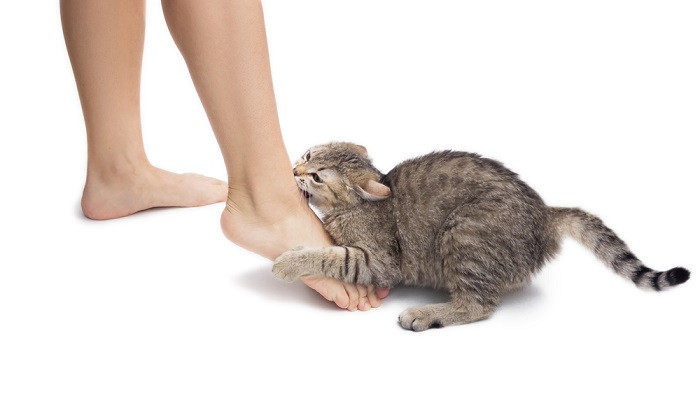 Cat seeking attention
Cat seeking attention
In some cases, cats learn that biting gets them attention. If you react to a gentle nip by giving your cat attention, even if it’s negative attention, you might inadvertently reinforce the biting behavior. Your cat may learn that a bite is an effective way to initiate interaction.
If you suspect attention-seeking biting, the best approach is to withdraw attention immediately when your cat nips. Ignore the bite and walk away. Once your cat is calm, you can re-engage in interaction on your terms.
Stop the Nip: How to Prevent Petting-Induced Biting
Understanding why your cat bites during petting is the first step. Here’s how to minimize these unwanted nips and create more enjoyable petting sessions:
- Learn Your Cat’s Body Language: Become a feline body language expert! Pay close attention to the subtle cues your cat gives during petting. Recognize the early warning signs of overstimulation and stop petting before your cat reaches their biting point.
- Control the Petting Session: Keep petting sessions short and sweet, especially initially. End the petting session before your cat shows signs of overstimulation. Leave them wanting more!
- Pet Preferred Areas: Focus your petting on areas cats generally enjoy most, such as the head, cheeks, and under the chin. Avoid or limit petting on potentially sensitive areas like the belly, tail, and legs, unless you know your cat enjoys it.
- Observe and Adapt: Every cat is an individual. Pay attention to your cat’s preferences and adjust your petting style accordingly. What one cat loves, another might dislike.
- Provide Alternatives: If your cat enjoys mouthing or nipping during play, redirect this behavior onto appropriate toys. Offer a toy to bite instead of your hand during play sessions.
- Rule Out Medical Issues: If the biting behavior is new or sudden, consult your veterinarian to rule out any underlying medical conditions that might be causing pain or discomfort.
- Create a Calm Environment: Ensure your cat feels safe and secure in their environment. Stress and anxiety can contribute to unwanted behaviors, including biting.
Expert Tip: “Understanding your cat’s individual personality and communication style is key to a harmonious relationship. Petting should be a positive experience for both you and your cat. By learning to listen to your cat’s subtle cues, you can create petting sessions that are enjoyable and bite-free.” – Dr. Sarah Meowser, Certified Feline Behaviorist.
Conclusion: Building a Bite-Free Bond
“Why Does My Cat Bite Me When I Pet Her?” is a common question among cat owners. The answer often lies in understanding feline communication and respecting their individual boundaries. Petting-induced biting is usually not a sign of aggression, but rather a communication signal, a way for your cat to say “enough for now!”.
By learning to recognize your cat’s body language, respecting their petting limits, and creating positive interactions, you can build a stronger, more affectionate bond with your feline companion, free from unexpected nips. Remember, a little understanding goes a long way in the world of cat-human communication!
Further Reading: Decoding Your Cat’s Language: A Guide to Feline Communication
Frequently Asked Questions
Q: Why does my cat suddenly bite me when I’m petting her and she seems to be enjoying it?
A: This is most likely due to overstimulation. Cats have a petting threshold, and once that’s reached, they may bite to signal they’ve had enough. Even if they seemed to enjoy it initially, their tolerance can be quickly exceeded.
Q: Sometimes my cat grabs my hand and bites when I pet him. Why?
A: This could be a sign of overstimulation, or that your cat dislikes being petted in a particular area. It can also be a playful behavior if the bite is gentle. Some cats also exhibit “love bites” as a form of affection, though these are usually very gentle nips.
Q: How can I train my cat to not bite me when I pet her?
A: You can’t “train” a cat not to have natural reactions, but you can manage the situation. Learn to recognize your cat’s body language indicating they are nearing their limit and stop petting before they bite. Avoid using your hands in rough play, and always offer toys for biting and play. Positive reinforcement, such as treats and praise when they tolerate petting without biting, can also be helpful.
Q: Is it normal for cats to bite when being petted?
A: Gentle nips, or petting bites, are relatively common and are often a normal form of feline communication. However, aggressive biting is not normal and could indicate fear, pain, or a behavioral issue that needs addressing.
Q: Should I punish my cat for biting me when I pet her?
A: No, never punish your cat for biting. Punishment will likely make the behavior worse, create fear and anxiety, and damage your relationship. Instead, focus on understanding the reasons behind the biting and managing the situation by respecting your cat’s boundaries and learning their communication signals.
Want to deepen your understanding of your cat’s behavior? Download our free guide to cat behavior and unlock the secrets to a happier, healthier relationship with your feline friend!
Get Your Free Cat Behavior Guide Now!
Explore More About Cat Behavior:
Understanding Cat Behavior Problems
Why Do Cats Hiss? Decoding Feline Hissing
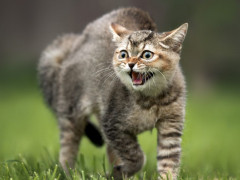 cat hissing and arching his backs
cat hissing and arching his backs
Why Is My Cat Peeing Outside the Litter Box?
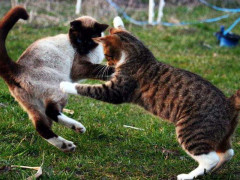 The image seems to depict a cat displaying signs of aggression or discomfort towards another cat.
The image seems to depict a cat displaying signs of aggression or discomfort towards another cat.
Popular Reads in Our Community:
Cat Basics: Essential Cat Care Tips
How Smart Are Cats? Unveiling Feline Intelligence
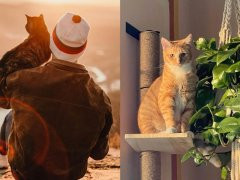 A split view of a cat owner holding their orange cat in their arms, and the orange cat looking straight into the camera
A split view of a cat owner holding their orange cat in their arms, and the orange cat looking straight into the camera
Decoding Feline Behavior: Play Fighting or Real Fighting?
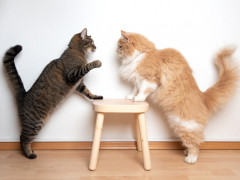 An image depicting cats engaging in interactions that blur the line between fighting and playing, highlighting the sometimes ambiguous nature of feline behavior.
An image depicting cats engaging in interactions that blur the line between fighting and playing, highlighting the sometimes ambiguous nature of feline behavior.
Leave a Reply

